

|
Home Updates Hydros Cars Engines Contacts Links Contact On The Wire |
Historic Hydros by R.T.Pole
|
|
George Lines’ Sparky II In 1990, that illustrious scribe on all matters relating to tethered hydroplanes, R.T.Pole, published the following article. We are indebted to him for permission to republish this appreciation of Sparky II. If you described Sparky II as the first modern tether hydroplane, you would not be very far wrong, for it incorporated the following aspects of design that are still adhered to today. It was the first published design to have at, one time. 1) slimline hull, 2) outrigger sponsons, 3) purpose built glow plug engine, 4) surface propeller, 5) bridle attachment to line. |
|
Built in 1949/50 it totally dominated B class racing for years and spawned, not only Big Sparky, a 30cc scaled up version, but many scaled down 10cc versions. The hull comprised of 1 mm resin bonded plywood with ¼ in square hardwood stringers, the sponsons were from block balsa and in the area of the engine ¼ in ply stiffening plates were used, the engine crankcase having very thick lugs with bolts passing through horizontally into blind holes instead of vertically as in modern practice. The tether points were bolted through the outer skin to load spreading Dural plates on the inside. To enable successful launches to be obtained on rough water, clip-on alloy plates were fitted between the sponson bars, however, these tended to generate lift and cause a flip at speeds much above 50mph. Right: Sparky II as pictured in the Model Engineer in 1950 |
|
The engine was of 14.22cc with 9:1 compression ratio (usually) and was over-square with a 11/8in. bore to only 7/8in. stroke. The exhaust and transfer porting were 360 degrees, and the flat topped piston had no rings. The 1/2in. diameter crankshaft ran on two ball races, there was a floating bush big end, and the crank pin drove the rear located rotary valve. The plug-in contra piston enabled the compression ratio to be varied by screwing the integral head and barrel finning up and down, and as the engine was designed as a glow plug unit from square one no provision was made for spark ignition.
Materials used in the engine were as follows: Cylinder barrel meehanite, crankshaft silver steel, crank webs cast steel, crank pin turned from a high tensile steel bolt then case hardened and press fitted to the crank web. The whole crank unit was balanced. The main crankcase was turned from Dural and left fairly chunky, and the flywheel was a brass rim with a Dural inner concentrically screwed together with 6 equi-spaced 4BA screws. The drive for the propshaft was formed in the end of the crankshaft. The rotary valve disc was also made from Dural and ran on a 1/4in. diameter silver steel pin. The carburettor was of 13/32in. bore with a 'cross tube' spraybar jet, this comprised a 1/8in. diameter brass tube drilled size 60 to form the jet, with a silver steel needle and knurled head set up on a 1/8in x 40 TPI thread which gave fairly accurate adjustment.
|
|
The cylinder porting for the exhaust comprised ten equi-spaced rectangular ports 9/32in. wide x 5/32in.deep, the transfer ports finishing 3/64in. below the bottom of these. The manifold for originally one then twin silencers was from Dural and held in position by a finned cast iron ring that was bolted through to the crankcase. The head and barrel finning was turned from Dural and the contra piston was from cast iron. The piston was from meehanite and was carefully lapped into the cylinder. The connecting rod and little end yoke were Dural once again and held to the piston with iron rivets. |
The total weight of the boat was between 6 1/2 and 7lb and although the record breaking runs where done on a mixture of 10% nitro methane, 25% castor oil and 65% methanol, most regattas were completed on a straight methanol/castor oil mix. The propeller was two bladed of 6 1/2. to 8in. pitch x 3 3/8 diameter.
|
Reckoned by many experts at the time to be the most powerful 15cc engine then built it was not surprising to see Sparky II dominate the B class for a good number of years; setting records in 1949 of 58.75mph, an increase of 16% on the then class record; In 1950 three records were claimed, the 300 yards at 64.60mph, 500 yards at 61.0mph and 1000 yards at 56.50mph. In 1954 the 500 yard record was pushed up to 62.36mph and as late as 1955 a new mark of 66.41 was set for the 500 yards. |
|
Wins in the B class of the MPBA International took place in 1950, 1951, 1952 and 1953 at speeds of between 49.41 and 59.10mph and the Model Engineer Speed Boat Competition results were even better with 1949 overall 1st place at 58.75mph, 1950 the same at 61.0mph, B class winner in 1951 at 58.60mph, B class winner 1952 at 60.10mph,missing in 1953 but second in class B in 1954 at 62.36mph after which no further entries were made.
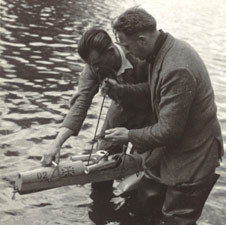 |
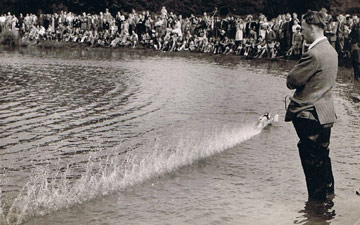 |
| George being assisted by Stan Poyser | Racing at Southampton Common |
At regattas, results were best possibly in the 1950 and 1951 seasons, when the following awards over and above those listed were won and retained; The Mears Trophy, The Miniature Speed Trophy, The Bedford Cup, The South London Trophy and The Paten Cup. All in all a very successful boat especially when you remember that George also ran Big Sparky and set A class records, and a paddle hydro which also managed about 40mph.
Post Script from OTW.
It was as a Design and Technology student in the late 60s that I first saw a picture of Sparky II. By then it was 20 years old, but it seemed so modern compared with many of the contemporary boats illustrated. I used Sparky as an example of the ‘if it looks right, it is right’ principle and it remained an ‘iconic’ design in my mind from then on. Like so many tethered hydroplanes, Sparky, sadly, was lost or destroyed at some stage and so I would never see it in the flesh so to speak. This was not quite the end of the story however. In 1998 an article appeared in Model Engine World revealing that the original engine of Sparky II had been discovered and retrieved by Peter Hill of the Retro Racing Club.
 |
Thanks to the late Terry Everitt and his invaluable address book, OTW was able to piece together a more accurate account of how the engine survived. Development during the 50s was rapid and Sparky II was quickly followed by newer and faster versions. In 1957 George Lines emigrated to America and took with him with his 30cc Big Sparky boat. There he enjoyed a series of races against Charles Watkins. In America there were no noise restrictions so the silencer was removed and the boat proved to be similar in speed to the best of the American Boats. On the right: Charles Watkins 30cc American record holder with George Lines 30cc British and European record holder. Marquette Park, Chicago, 1957. Picture by Tom Perzentka courtesy P. Hill |
Before he left, George had passed one of his newer boats and a selection of engines and parts to the teenage John Skingley, son of Jack and Olive Skingley. Jack, who sadly died in 1953 had, along with his brother Arthur, started building boats and competing in the 30s and Olive was a very well established competitor in her own right. John ran his yellow ex Lines boat at several regattas before parting with it and moving on to other pursuits.
|
In 1960 Olive married Arthur Cockman, who had built the first of his famous series of IFIT flash steam hydros back in 1930. Following Arthur’s death in 1993 Olive loaned the last of his boats, IFIT 9, to the tethered hydroplane collection at Pitsea. During a visit to collect IFIT, Peter Hill and Stuart Robinson discovered the original Sparky engine (pictured right) in a biscuit box in a cupboard. The piston and adjustable contra piston were missing but essentially the engine was complete and in the form it had last run. A part built engine of similar style was also amongst the parts discovered. This engine was of the same capacity but far smaller physically and designed from scratch for 360 degree porting. Fast-forward several years, and Peter Hill very generously allowed me to borrow the original engine to examine and record it for this article. After discussion, a plan was formulated to construct a replica hull and for Mike Crisp to make the missing parts and refurbish the engine so that finally I could see the boat that so intrigued me over 35 years ago. |
|
|
|
Examination of the engine reveals the development it went through in its 5 years of competition. The motor was originally built in the conventional ‘loop scavenged’ form with a single exhaust. The change to radial porting and the beautiful twin silencers were the first major alteration and it is this form that is detailed in R.T. Pole’s article. The next change was enforced as the back plate fractured and a new one fitted with the venturi in the 12-oclock position. This put the fresh fuel mixture straight on to the big end but required a drag link on the rotary valve to give the correct timing. The valve disc was also changed from aluminium to tufnol. Sparky II, along with Ken Williams’ Faro is extensively documented and photographed; yet none of the published photographs match the plans, which were published in 1951. The replica was built using the engine as reference and the plans as a guide. Interpretation of photos provided solutions to most of the design ‘dilemmas’. Sparky II replica with clip-on plates on sponson bars |
A selection of Sparky derived motors
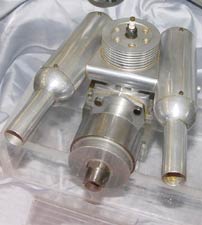 |
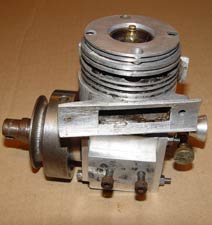 |
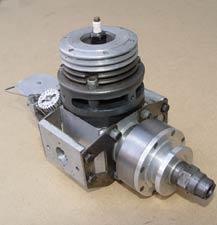 |
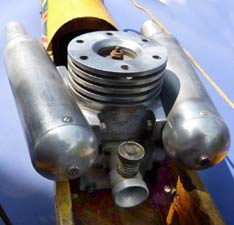 |
| Late Alan Rayman | Late Stan Poyser | Unknown 10cc | 15cc by Mr Dixon of Victoria |
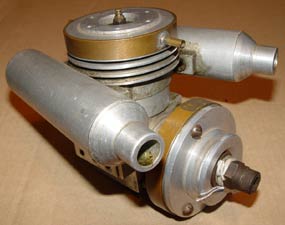 |
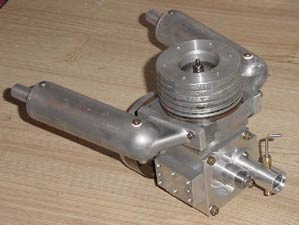 |
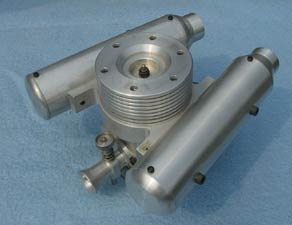 |
| Ex Gerry Buck. Water cooled | PR silencers modern addition | 30cc by Len Lara of Victoria |
Thanks go to the late Terry Everitt, John and Ron Skingley for completing the story. Keith Shepherd, Tony Pilliner, Stuart Robinson, Norman Lara and the Westbury family for the loan of motors and original photos.
|
|
Jildi Junior
|
In 1933 Captain C.E. Bowden turned his attention from model aircraft to model speedboats, with the intention of seeing if the application of model aircraft principles, in both design and construction, would help to forward the performance of the then smallest class of hydroplane, that is those under 7lb total weight.
In advance of these experiments a metre boat Jildi fitted with a 30cc Atom III two-stroke petrol engine was built to gain operating experience. A reasonable performance was obtained and in 1934 plans were drawn up for a smaller version to be called Jildi Junior. This was of very light balsa construction, 30in. long and 6in beam; the planning angles were rather coarse with the V shape of the forward hull carrying through to the step. The whole design proved unstable and was scrapped.
|
A return to the drawing board resulted in the design shown in the plan, (below) Jildi Junior II. With finer planning angles and greater beam. Not being an engine builder himself, the choice of a power unit was limited to a commercial model aircraft engines of which the Westbury designed Atom Minor, manufactured by A.E. Jones Ltd, was deemed, with modifications, to be the most suitable. Modifications included opening out the ports and fitting of a simple carburettor as designed by Mr Andrew Rankine (builder of the highly successful Oigh Alba). To compensate for the increase in revs a stronger contact breaker spring was also fitted. The Atom Minor was a two-stroke air-cooled petrol engine of 1in. bore and 1.125in. stroke, giving approximately 15cc and was of side port configuration. Final tuning of the engine was carried out by Mr Rankine. |
|
The hull was to be as light and strong as possible and the illustration shows the general detail of the materials used, cross section and method of construction. Durofix glue was used throughout the construction and the complete timber framework waterproofed with cellulose varnish, before being covered with thin model aeroplane jap silk. After drying, the excess silk was trimmed off with sharp scissors, a coat of full strength model aircraft dope was then applied to shrink the silk, followed by two coats of paint and one of clear varnish.
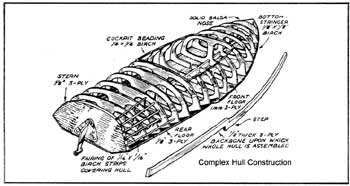 |
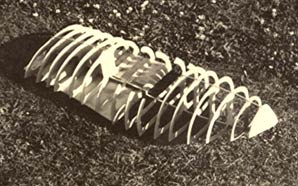 |
| Hull lines from FJ Camm 'Model Boat Building' | Part built hull by S.A.C.Smith of Electra Engines |
The engine mounting consisted of two alloy angles bolted to the crankcase with through bolts, then screwed with coarse wood screws to longitudinal ash bearers. A small knuckle joint took the drive from the end of the engine crankshaft to a 3/16in. dia. Silver steel shaft, which connected directly to the propeller, no universal being regarded as necessary. The prop was 3in. dia. two-bladed and of 9in. pitch, constructed of sheet steel brazed to a phosphor bronze hub. Forward thrust was taken by a small ball-race, which ran against the rear of another phosphor bronze bearing, fitted to a 1/16in thick brazed steel skeg. The propellor was held in place with a grub screw and a streamlined dural tail piece. No propshaft tube was fitted as the shaft ran directly in plastic wood filler, which plugged the slot in the rear hull floor, a dural plate locating the shaft as it entered the engine compartment.
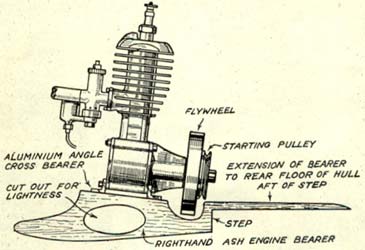 |
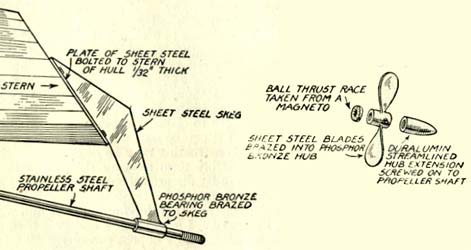 |
To the rear of the main cockpit a smaller compartment housed a 4½ volt dry battery, this was housed in oiled silk during running operations. Fuel was supplied from a 2½in. long x 1½in. dia. brass tank, which was pressurised with a football bladder during starting up operations. The mandatory single line attachment was made to an 18swg, multi position clip, adjacent to the engine cockpit.
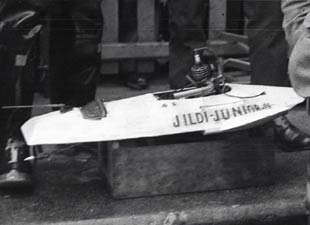 |
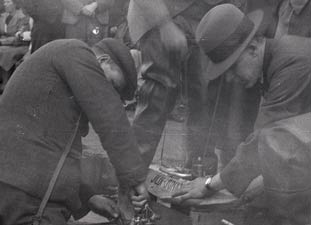 |
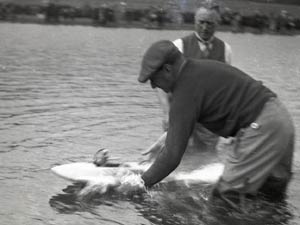 |
The total weight, less fuel, of 6lb. 4oz. was well within the Class C weight limit for the Model Engineer Speedboat Competition. The result of this work was an average speed for the 300yd. run of 24.78mph. This was confirmed as a new World Record for this class of boat as the 17.05mph. of the second placed model had been regarded up to then as a good speed for so small a model.
|
Having proved his ideas with Jildi Junior II Captain Bowden appears to have reverted to model aircraft although not before constructing and testing two more models in 1937. One was a 40in. long all balsa boat with a multi stepped hull powered by a 25cc water cooled two-stroke, the other a tiny boat fitted with a 2.3cc petrol engine which was run free and stopped with an aero type time switch. In conclusion it is worth re-telling the story of when the good Captain was asked by Edgar Westbury the origination of the name Jildi. He explained that it was an Indian Army term in Hindustani for ‘put a jerk in it’ or ‘go quickly’, which no one can possibly deny that it did. Right: Col. Bowden at Victoria Park with another version of Jildi Junior |
|
OTW Update. Jildi Junior was passed into the care of Lieut. Cmdr. Alwyn Greenhalgh to join his amazing and well documented collection of vintage model aircraft. He was a prodigious model engineer and author, and responsible for saving a huge number of early models that may well have been lost forever. His writings can be found in all the contemporary modelling publications along with examples of his restoration skills. Jildi Junior underwent a total restoration in his hands to what is now described as 'concours condition'. The later 'sponsons' were removed leaving the hull in its original single step configuration with the engine and fittings as described by the 'Captain'.
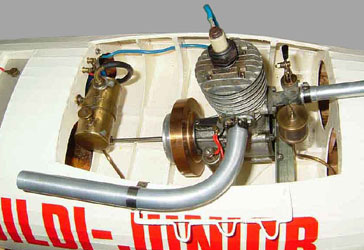 |
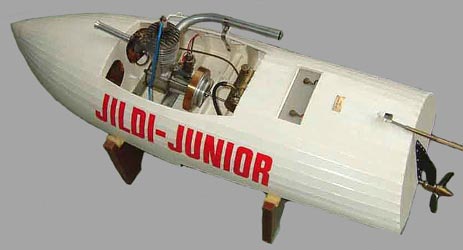 |
Alwyn Greenhalgh sadly died a few years ago but unlike many recent cases, his collection was not broken up and along with Jildi Junior, has now been passed on for safe keeping.
Thanks to Tim Westcott for relating the later history of Jildi and providing the photographs of the boat in its current state. Additional photos courtesy of the Westbury family. Photo of part built hull by courtesy of Ken Smith
©copyrightOTWandPeterHill2016